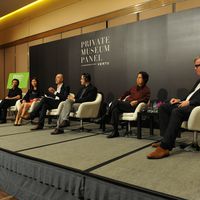Shannon Frady talks to Li Zhen Hwa, film producer and curator whose ideas reflect the changing landscape and the thoughts of the country’s people. He talks about the latest film he has produced, “Xin Jing” and the independent scene he has been involved in.
China’s cultural evolution since the Cultural Revolution is fascinating to observe. Perhaps no one is better to host as narrator than Li Zhen Hwa, 33-year old curator and instigator of culture in Beijing, whose latest venture into film will be part of this evolution, as China finds its soul in its post-revolutionary adolescence.
“Xin Jing” – Literally, “Heart Study” – is a project whose title is lifted from Buddhist texts. Its tentative English title is “368 Gram Heart.” The feature will be filmed on DV on an island called Gulang Yu in Southern China.
Michael Stipe of R.E.M., when asked about “This one goes out to the one I love” once commented that “There are so many love songs, and there are so many which are so poorly written.” “Heart,” while not so concerned with the writing, is a love story in which the visual experience plays a much more important part in telling the story.
The plot is actually about two guys and a girl, and the girl facilitates the balance of the two men; she gives one man a sexual fantasy, more based on imagination, and she is raped by the other man. But in the end both men die. The first man, who gives her his heart… it’s very surreal in that he takes his heart out, more as a suggestive hint; this is an expression from Buddhism of how to equalize one’s own heart in society by loving other people or by being loved.
But about one-fifth of the film is plot, and the rest is sound, design, art experience. It’s very difficult to explain. Wong Kar-Wai does more with the visual with not so much dialogue. We are combining Wong Kar-Wai and Hollywood; we design the sets, and have the basic dialogue, but we give more free reign to the actors to improvise on the dialogue.
After about one month of filming, we may change the whole story in the editing. We have the best graphic designers, but we are all working on a very low budget – 100,000 RMB.
China has a lot of really smart people, and it’s easy for them to adopt DVD technology to pirate films. The population is so large, and so many are hungry for culture, but there are a lot of government limitations. Only 18 foreign films are officially allowed every year, for example. The US Embassy’s Economic Section is working with the Motion Picture Association on how to come over the market access issue. On DVDs the Embassy’s Economic Section takes it for granted that there are going to be copies around. The actual problem is that there aren’t many movies accessible by Chinese people. But the Americans believe this can be alleviated by opening up the entertainment market, working together with Chinese film companies, to try to make more quality films available to the public in China. Do you see yourself as somehow playing a role in this?
China at this moment, I am not sure if they can pay for it or whether they can understand films like this. For China, I think that world-famous film directors and actors and actresses should come to China to promote film. We could set up a big show. At this moment I am working with the Dogma Group from Denmark, which is composed of filmmakers and film teachers. I am still negotiating their trip to China.
This film is a break from anything commercial. This is my first feature as a producer, and the first feature for the director. With the melody, the design of the film, and the number of people working on the film, it’s not what people might think of as necessarily independent in China (which is usually only 1 or 2 people working on the film). There are about 15 people working on this project.
There are two advisors for the design. One is an art director for Vision Magazine, and the other runs his own design company here in Beijing, Icon. They will work on post. Both are also really good at 3d design.
The set will be created by two well-recognized Beijing artists, Liu Ding and Shi Qing, who was also one of the artists featured in the Tokyo exhibition which I helped organize last year.
As creatives, we follow our own artistic instincts to find the best shots and angles.
I am more involved in the art scene in China instead of a filmmaker, but the meaning of curator on one side is creativity and the other side is management. For some projects as a curator, I am more of a concept person but I can also focus more on management if someone else’s concept is already in place.
This year however I am more of a freelance writer for magazines, and more involved in filmmaking and TV.
The TV series is about art, power and politics. It centers around about twenty of the most influential people involved in the arts, film, music, dance, theater, through interviews. It will give people a rough but good understanding of the development of Chinese art and music since 1985.
The series will be a very honest portrayal of the reality of dealing with the commercial aspects of making it as an artist. There will also be some people from real estate companies who for example have invested 20 million RMB for a museum, and what they want to achieve. Who constructs the art world, and for whom? And, which kinds of audiences are out there, what do people like? Although there are a lot of people in this country, people have certain tastes. This is part of my study of what projects to do for the future.
Shannon Frady talks to Li Zhen Hwa, film producer and curator whose ideas reflect the changing landscape and the thoughts of the country’s people. He talks about the latest film he has produced, “Xin Jing” and the independent scene he has been involved in.
China’s cultural evolution since the Cultural Revolution is fascinating to observe. Perhaps no one is better to host as narrator than Li Zhen Hwa, 33-year old curator and instigator of culture in Beijing, whose latest venture into film will be part of this evolution, as China finds its soul in its post-revolutionary adolescence.
“Xin Jing” – Literally, “Heart Study” – is a project whose title is lifted from Buddhist texts. Its tentative English title is “368 Gram Heart.” The feature will be filmed on DV on an island called Gulang Yu in Southern China.
Michael Stipe of R.E.M., when asked about “This one goes out to the one I love” once commented that “There are so many love songs, and there are so many which are so poorly written.” “Heart,” while not so concerned with the writing, is a love story in which the visual experience plays a much more important part in telling the story.
LZH: The plot is actually about two guys and a girl, and the girl facilitates the balance of the two men; she gives one man a sexual fantasy, more based on imagination, and she is raped by the other man. But in the end both men die. The first man, who gives her his heart… it’s very surreal in that he takes his heart out, more as a suggestive hint; this is an expression from Buddhism of how to equalize one’s own heart in society by loving other people or by being loved.
But about one-fifth of the film is plot, and the rest is sound, design, art experience. It’s very difficult to explain. Wong Kar-Wai does more with the visual with not so much dialogue. We are combining Wong Kar-Wai and Hollywood; we design the sets, and have the basic dialogue, but we give more free reign to the actors to improvise on the dialogue.
After about one month of filming, we may change the whole story in the editing. We have the best graphic designers, but we are all working on a very low budget – 100,000 RMB.
SLF: China has a lot of really smart people, and it’s easy for them to adopt DVD technology to pirate films. The population is so large, and so many are hungry for culture, but there are a lot of government limitations. Only 18 foreign films are officially allowed every year, for example. The US Embassy’s Economic Section is working with the Motion Picture Association on how to come over the market access issue. On DVDs the Embassy’s Economic Section takes it for granted that there are going to be copies around. The actual problem is that there aren’t many movies accessible by Chinese people. But the Americans believe this can be alleviated by opening up the entertainment market, working together with Chinese film companies, to try to make more quality films available to the public in China. Do you see yourself as somehow playing a role in this?
LZH: China at this moment, I am not sure if they can pay for it or whether they can understand films like this. For China, I think that world-famous film directors and actors and actresses should come to China to promote film. We could set up a big show. At this moment I am working with the Dogma Group from Denmark, which is composed of filmmakers and film teachers. I am still negotiating their trip to China.
SLF: Does your work, then, tie in with anything commercial?
LZH: This film is a break from anything commercial. This is my first feature as a producer, and the first feature for the director. With the melody, the design of the film, and the number of people working on the film, it’s not what people might think of as necessarily independent in China (which is usually only 1 or 2 people working on the film). There are about 15 people working on this project.
There are two advisors for the design. One is an art director for Vision Magazine, and the other runs his own design company here in Beijing, Icon. They will work on post. Both are also really good at 3d design.
The set will be created by two well-recognized Beijing artists, Liu Ding and Shi Qing, who was also one of the artists featured in the Tokyo exhibition which I helped organize last year.
SLF: The film seems to more design-focused.
LZH: As creatives, we follow our own artistic instincts to find the best shots and angles.
SLF: Are you more of a curator or producer?
LZH: I am more involved in the art scene in China instead of a filmmaker, but the meaning of curator on one side is creativity and the other side is management. For some projects as a curator, I am more of a concept person but I can also focus more on management if someone else’s concept is already in place.
This year however I am more of a freelance writer for magazines, and more involved in filmmaking and TV.
SLF: Could you share something about the TV series you are producing?
LZH: The TV series is about art, power and politics. It centers around about twenty of the most influential people involved in the arts, film, music, dance, theater, through interviews. It will give people a rough but good understanding of the development of Chinese art and music since 1985.
The series will be a very honest portrayal of the reality of dealing with the commercial aspects of making it as an artist. There will also be some people from real estate companies who for example have invested 20 million RMB for a museum, and what they want to achieve. Who constructs the art world, and for whom? And, which kinds of audiences are out there, what do people like? Although there are a lot of people in this country, people have certain tastes. This is part of my study of what projects to do for the future.
More on Li Zhen Hwa
About the writer:
In 1987, at 16, between a photojournalistic tour of war-torn Nicaragua and an internship at world-renowned photojournalist agency Magnum Photos, Shannon Lowell Frady had begun to acquire his basics in media. Born in Atlanta, Georgia, USA, Shannon grew up in New York City for eight years before attending Syracuse University to study photojournalism at the Newhouse School of Public Communications. Shannon moved to Beijing in 2002 after some years in Honolulu and New York. He is currently based there doing work for major magazines and clients.
Shannon Frady talks to Li Zhen Hwa, film producer and curator whose ideas reflect the changing landscape and the thoughts of the country’s people. He talks about the latest film he has produced, “Xin Jing” and the independent scene he has been involved in.
China’s cultural evolution since the Cultural Revolution is fascinating to observe. Perhaps no one is better to host as narrator than Li Zhen Hwa, 33-year old curator and instigator of culture in Beijing, whose latest venture into film will be part of this evolution, as China finds its soul in its post-revolutionary adolescence.
“Xin Jing” – Literally, “Heart Study” – is a project whose title is lifted from Buddhist texts. Its tentative English title is “368 Gram Heart.” The feature will be filmed on DV on an island called Gulang Yu in Southern China.
Michael Stipe of R.E.M., when asked about “This one goes out to the one I love” once commented that “There are so many love songs, and there are so many which are so poorly written.” “Heart,” while not so concerned with the writing, is a love story in which the visual experience plays a much more important part in telling the story.
LZH: The plot is actually about two guys and a girl, and the girl facilitates the balance of the two men; she gives one man a sexual fantasy, more based on imagination, and she is raped by the other man. But in the end both men die. The first man, who gives her his heart… it’s very surreal in that he takes his heart out, more as a suggestive hint; this is an expression from Buddhism of how to equalize one’s own heart in society by loving other people or by being loved.
But about one-fifth of the film is plot, and the rest is sound, design, art experience. It’s very difficult to explain. Wong Kar-Wai does more with the visual with not so much dialogue. We are combining Wong Kar-Wai and Hollywood; we design the sets, and have the basic dialogue, but we give more free reign to the actors to improvise on the dialogue.
After about one month of filming, we may change the whole story in the editing. We have the best graphic designers, but we are all working on a very low budget – 100,000 RMB.
SLF: China has a lot of really smart people, and it’s easy for them to adopt DVD technology to pirate films. The population is so large, and so many are hungry for culture, but there are a lot of government limitations. Only 18 foreign films are officially allowed every year, for example. The US Embassy’s Economic Section is working with the Motion Picture Association on how to come over the market access issue. On DVDs the Embassy’s Economic Section takes it for granted that there are going to be copies around. The actual problem is that there aren’t many movies accessible by Chinese people. But the Americans believe this can be alleviated by opening up the entertainment market, working together with Chinese film companies, to try to make more quality films available to the public in China. Do you see yourself as somehow playing a role in this?
LZH: China at this moment, I am not sure if they can pay for it or whether they can understand films like this. For China, I think that world-famous film directors and actors and actresses should come to China to promote film. We could set up a big show. At this moment I am working with the Dogma Group from Denmark, which is composed of filmmakers and film teachers. I am still negotiating their trip to China.
SLF: Does your work, then, tie in with anything commercial?
LZH: This film is a break from anything commercial. This is my first feature as a producer, and the first feature for the director. With the melody, the design of the film, and the number of people working on the film, it’s not what people might think of as necessarily independent in China (which is usually only 1 or 2 people working on the film). There are about 15 people working on this project.
There are two advisors for the design. One is an art director for Vision Magazine, and the other runs his own design company here in Beijing, Icon. They will work on post. Both are also really good at 3d design.
The set will be created by two well-recognized Beijing artists, Liu Ding and Shi Qing, who was also one of the artists featured in the Tokyo exhibition which I helped organize last year.
SLF: The film seems to more design-focused.
LZH: As creatives, we follow our own artistic instincts to find the best shots and angles.
SLF: Are you more of a curator or producer?
LZH: I am more involved in the art scene in China instead of a filmmaker, but the meaning of curator on one side is creativity and the other side is management. For some projects as a curator, I am more of a concept person but I can also focus more on management if someone else’s concept is already in place.
This year however I am more of a freelance writer for magazines, and more involved in filmmaking and TV.
SLF: Could you share something about the TV series you are producing?
LZH: The TV series is about art, power and politics. It centers around about twenty of the most influential people involved in the arts, film, music, dance, theater, through interviews. It will give people a rough but good understanding of the development of Chinese art and music since 1985.
The series will be a very honest portrayal of the reality of dealing with the commercial aspects of making it as an artist. There will also be some people from real estate companies who for example have invested 20 million RMB for a museum, and what they want to achieve. Who constructs the art world, and for whom? And, which kinds of audiences are out there, what do people like? Although there are a lot of people in this country, people have certain tastes. This is part of my study of what projects to do for the future.
More on Li Zhen Hwa
About the writer:
In 1987, at 16, between a photojournalistic tour of war-torn Nicaragua and an internship at world-renowned photojournalist agency Magnum Photos, Shannon Lowell Frady had begun to acquire his basics in media. Born in Atlanta, Georgia, USA, Shannon grew up in New York City for eight years before attending Syracuse University to study photojournalism at the Newhouse School of Public Communications. Shannon moved to Beijing in 2002 after some years in Honolulu and New York. He is currently based there doing work for major magazines and clients.





